0 Introduction
The need for energy security has triggered an initiative for international cooperation to provide a stable and sufficient energy supply [1].As the power industry continues to evolve, a significant number of blackouts worldwide are attributed to instability arising from increased intersystem connections, expansion of power systems,and advancements in power system control technology[2].Reference [3] reported that insufficient damping of oscillations in practical power systems is one of the most common problems in the energy industry.
One of the anticipated Association of Southeast Asian Nations (ASEAN) international connections is the 500 kV high-voltage direct current (HVDC) link between the Philippine national grid and the Sabah power grid, which is expected to be realized by 2020 [4].The Philippines-Sabah interconnection is a step towards creating the ASEAN Economic Community (AEC), which recognizes the adverse effects of climate change.With a campaign for greener and cleaner energy sources, the community has pledged to use more renewable energy sources alongside fossil fuels.This, in effect, will further complicate the system’s components and controls.The ASEAN Interconnection Master Plan Study (AIMS) II confirmed that the proposed interconnection is technically and economically feasible within the region, even though small-signal stability and the impact of renewable energy sources are absent from its scope of network analyses.
The archipelagic Philippines has isolated and interdependent power systems.Studying the effects of domestic interconnection aimed at addressing the problems[5] in the southern grid (Mindanao) of the country has been the motivation of this study, as well as investigating the effect of possible international interconnection.Furthermore,the aggressive targets for renewable energy (RE) sources[6] drove the need for this study to examine their immediate effects on existing systems when interconnected, which was not perceived earlier.The authors in [7] have applied the system stability approach to study the impacts of various penetration levels of renewable energy sources on Java-Bali interconnections.Reference [8] reviewed various studies to understand the impact of VRE integration based on different generation types, penetration levels, and power grid characteristics.The authors suggested that balancing issues arise after 20% generation and stability issues occur after more than 50% VRE penetration.The authors in [9]analyzed and quantified system performance in terms of reliability and vulnerability to changing renewable sources.Standard test systems, that is, the IEEE RTS-96 and IEEE RTS-GMLC test networks, were used to analyze their performance.The authors in [10] reviewed the impacts of various technological solutions and challenges in power systems and suggested a matrix with solutions versus challenges for renewable technologies.Reference [11]studied dynamic models of household power consumption demand using solar PV data to demonstrate the impacts of its distribution characteristics on the power grid.
The authors in [12] revealed that “Australia has struggled previously while maintaining system stability,despite having a high share of natural gas in their domestic electricity production portfolios”.Reference [13] presented a comprehensive evaluation index system to assess the benefits of transnational power grid interconnection projects.The authors in [14] comprehensively reviewed the different operational benefits and challenges of interconnected power grids.The authors in [15] studied and analyzed the impact of Arab counties on the stability of frequency in a Syrian electrical power grid with and without interconnections.Reference [16] presented a load frequency control approach by developing a general state-space model and then a 4-area power system modeled with renewable sources along with electric vehicles.The authors in [17] presented a fuzzy PID controller optimized with an improved ant colony optimization algorithm.The proposed method was tested on a multi-area, connected power system.A decentralized load-frequency control framework was presented in Ref.[18] using dynamic state estimation.This model was tested with the interconnection of four power systems, and it was claimed that the power fluctuations and tie-line deviations were efficiently controlled.
Most studies have focused on either standard tests or national-level systems.In addition, Philippines-Sabah interconnection data needs to be analyzed for renewable integration in terms of stability studies.
The contribution of this study is the modeling of the interconnection between the three islands of the Philippines and Sabah, Malaysia.Furthermore, the impacts of the three islands and their interconnections with Sabah were analyzed in terms of dynamic performance.Moreover, the impacts of renewable energy integration on the static and dynamic behavior of the proposed Philippines-Sabah interconnection were analyzed using the Power Systems Analysis Toolbox(PSAT) software.Various case studies were presented to fully understand the stability and performance of the proposed international link.Stability modeling was performed using PSAT.Another objective of this study is to bring the system’s consolidated power grid data to the national/international level and/or the public domain for further analysis by future researchers.However, this work extensively studied most of the operational aspects of the power system, including small signals, transient interconnections, and the integration of renewable energy.Appendix A provides the data file for further analysis.
1 Proposed methodologies
1.1 Small signal stability analysis
The behavior of a dynamic system can be described by a complete set of n first-order nonlinear ordinary differential and algebraic equations (DAE) [18] in the following form:

The complete set of differential equations with network equations is arranged in state-space form and linearized about an operating point as follows:
The small-signal perturbation model of the equation can be solved using a Laplace function.The poles of the system are the roots of the characteristic equations, which can be rewritten as:
The values of λ (λ= λ1, λ2, λ3…λn), which satisfy the characteristic equation, are known as the eigenvalues of matrix A.Complex eigenvalues always occur in conjugate pairs as follows:
In this study, the eigenvalues were calculated along with the damping ratio and frequency of oscillation for different cases, and the participation factor of ith mode.
1.2 Transient stability analysis
This study uses numerical integration for the timedomain simulation, specifically the trapezoidal method,which is an implicit method for solving time-domain analysis in PSAT [17].The system was simulated for 20 s in all cases.
In each generic iteration i and generic time step t + Δt, and q(i) are as follows:
and q(i) are as follows:

where, Ac(i) is a matrix depending on the algebraic and state Jacobian matrices of the system, q(i) is a function that depends on the implicit numerical method, Inx is the identity matrix of the same dimension of the dynamic order of the DAE system and all Jacobian matrices and f(i) are computed at the current point (x(i)(t + Δt), y(i)(t + Δt), t+Δt).
1.3 Solar photovoltaic generator model
ASEAN region has a very dynamic system; owing to its developing country members who are on the verge of improving their power systems, the inclusion of solar PV is slowly observed in some existing systems.Figure 1 shows a solar PV generator (SPVG) interconnected to the power grid.Solar panels, converters, and controllers, such as MPPT, are some of the major components [18].This model has no moving parts, indicating that the MPPT and controllers are instantaneous in this study.
The desired active power is the basis of the current setpoint.As such, the current (I) of the terminal voltage has the following dq form:
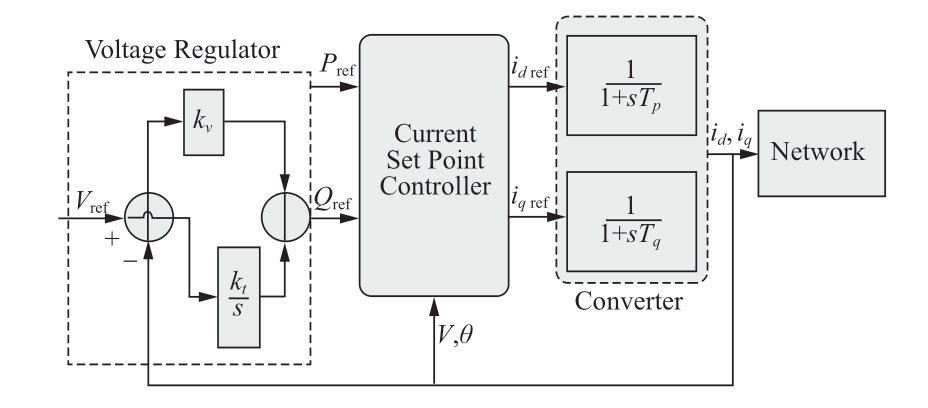
Fig.1 SPVG block diagram

1.4 Wind turbine system model
A model of the DFIG wind turbines was used in this study [18].In the simulations, all the wind farms were represented by DFIGs, as depicted in Fig.2.

Fig.2 Basic configuration of a DFIG wind turbine
The following equation (1) is the main basis for solving the wind turbine’s actual power.It is very useful in the derivation of the capacity of wind power.
where Cp is the utilization coefficient, ρ is the mass density of air, Ωw is the rotational velocity of the wind turbine, V is the wind velocity, A is the area of the blade.
It has the boons of fast acting when it comes to flux linkage dynamics, unlike the DFIG rotating masses dynamics.Hence, the following differential algebraic equations express a simplified model of DFIG based wind generation system:

where Te is the electrical torque, ψdr is the flux linkage due to d-axis rotor current, ψqr is the flux linkage due to q-axis rotor current, Iqr, Iqs are the q-axis rotor and stator current, respectively, Xr, Xm, Xs are mutual, rotor and stator reactances, ψds is the flux linkage due to d-axis stator current, ψqs is the flux linkage due to q-axis stator current,Ids, Idr are the d-axis rotor and stator current, respectively.
Balanced conditions were assumed for all operating conditions.All values solved in the above equations were considered per unit.A reference frame that was continuously rotating, where the q-axis led the d-axis frame by 90 electrical degrees, was also implemented during the simulation.
1.5 Power grid model development
Reference [5] has developed reduced and approximate Philippine models, which are utilized in this work.These models are created separately: Luzon, Visayas and Mindanao and an additional model, Sabah.The PSAT helps to have models for transmission lines, PV generators, PQ load, substation transformers, and reactive sources used for static power system components.The transmission lines in the model were developed by acquiring data such as line lengths, capacities, interconnectivity and conductor impedances.The transformers’impedances are normalized to a common base MVA rating also.All transformer impedances were assumed to follow the values in [16] and converted to a 100 MVA base.The generator’s location or connection point and maximum and minimum real and reactive power were the data needed for the power flow.All the grids were modeled with constant power loads.MW and MVAR data with a 0.9 power factor were considered,and these loads received high power in a high-voltage bus.This was performed to minimize the number of buses used.However, for Mindanao and Sabah, the loading conditions were based on the population of each region.Shunt compensation is rated as acceptable magnitudes needed to maintain acceptable bus voltage levels.Models have MVAr quantities.The voltage levels were maintained in the range of 1.05-0.95 p.u.
The generation and load data of WESM [19] on September 9, 2012, period 9 were used for the Luzon model, whereas for the Visayas reduced model, the WESM generation schedule of September 10, 2012, period 4, was used.The peak load conditions provided in the NGCP PubCon Presentation were used for the Mindanao Model[5].The Sabah model load was 874 MW on September 23,2013 [17].
The dynamic components are based on well-documented PSAT dynamic models for synchronous generators,turbine governors, automatic voltage regulators, solar photovoltaic generators, doubly fed induction generators,and wind turbines [20].Simple versions (classical) of synchronous generators were modeled, where the transient voltage in the q-axis was constant.All generators have no mechanical damping, and saturation effects are neglected.In this work, Model 1 TG was used for the conventional thermal generators, while Model 3 was selected for all the hydroelectric power generators, the same as the reference[21].In the latter model, the inelastic penstock, where the inertia of water and the ideal turbine, is considered.However, the parameters of these models are based on previous literature reviewed [22, 23] and that of the IEEE standard data.
1.6 Philippine power grid
A 900-ckt-km 500 kV line passing from north to south serves as the backbone of the Luzon power system, with a meshed 230 kV network from the center portion.It has a generation capacity of 7829 MW.
Visayas predominantly has a 138 kV voltage level for its power transmission system with some 230 kV connections.A mixture of coal, diesel, and geothermal power plants comprises the main generation profile of the Visayas grid,peaking at 1400 MW.Recent developments in the southern grid of the Philippines have added a 230 kV network to its existing 138 kV and 69 kV lines, which originally had a total of 3100 ck-km.Mindanao has experienced lower capacity together with its growing electricity demand.Sabah, Malaysia, has a power grid composed mainly of 275 kV, 132 kV and 66 kV system voltage levels, but 66 kV lines were not included in this study.A total of 2,272 circuit kilometers of both 275 kV and 132 kV were considered in this study.Sabah’s system relies heavily on gas-based generation in terms of both the generation mix and capacity.As shown in Fig.3, the Philippine-Sabah power grid is the realization of an international connection between Malaysia and the Philippines as part of the ASEAN Interconnection Master Plan.This assumes that the connection of the Visaya-Mindanao grid is realized.This includes a 500 MVA 250 kV two-pole HVDC link between the Luzon and Visayas grid (existing) and the isolated Mindanao grid, as planned in the 1995 transmission master plan study of the National Grid of the Philippines[24].The 500 MW, 500 kV link was achieved in PSAT connecting bus 34 (230 kV) and bus 116 (275 kV).In Fig.3,all link buses are denoted by the first letter of each island;for example, Luzon (L), Visayas (V), Mindanao (M), and Sabah (S).

Fig.3 Single line diagram of the Philippine-Sabah interconnected model
2 Results and discussion
2.1 Isolated grid (existing grids)
A base case was investigated by ensuring that the models without the new interconnection (Luzon-Visayas and isolated grids of Mindanao and Sabah) worked properly.The data in Appendix A were used for this purpose.Although not shown, the load flow results, for example,voltage levels, were observed to be within the limits, as expected.
More eigenvalues are observed in Fig.4a because this model comprises two groups of islands.The symbol“x”represents the eigenvalues, whereas the dotted lines represent 1% (closest to the y-axis), 5%, and 10% (farthest from the y-axis) damping lines.The eigenvalues nearest the y-axis (0% damping line) were the least damped eigenvalues.The rotor speed and angles were the least damped and prone to instability when small disturbances occurred.This may be caused by the lack of mechanical damping mechanisms (as assumed earlier) in these oscillatory machines.The least damped generator was located in the Visayas area and had the highest rating.
A fault was also applied to the system to further investigate its behavior when a large disturbance occurred.A three-phase fault, which was assumed to be the worst type of fault, was used in this study.In all models, the fault can be applied anywhere; however, for analysis, the fault is located either at the bus with the highest generator capacity or at the bus with the largest load.Therefore, other configurations should be investigated in future studies.The fault was applied at 0.2 s, followed by clearing after five cycles.
Since in the Philippines, the frequency is 60 Hz, the cycle is cleared after 0.0833 s.For simplicity, the same clearing time was used for the Sabah model, which is a 50 Hz system.Figures 5a and 5b show the deviations in the voltage profile and rotor angles observed in the Luzon-Visayas model, characterized by the rise in rotor angles after the 8th second.This is also observable in Fig.3a by the unstable fluctuation in voltage, which then increases after the 13th second.This model is the largest of the three existing grids, which is understandable because it is based only on approximate and reduced data.
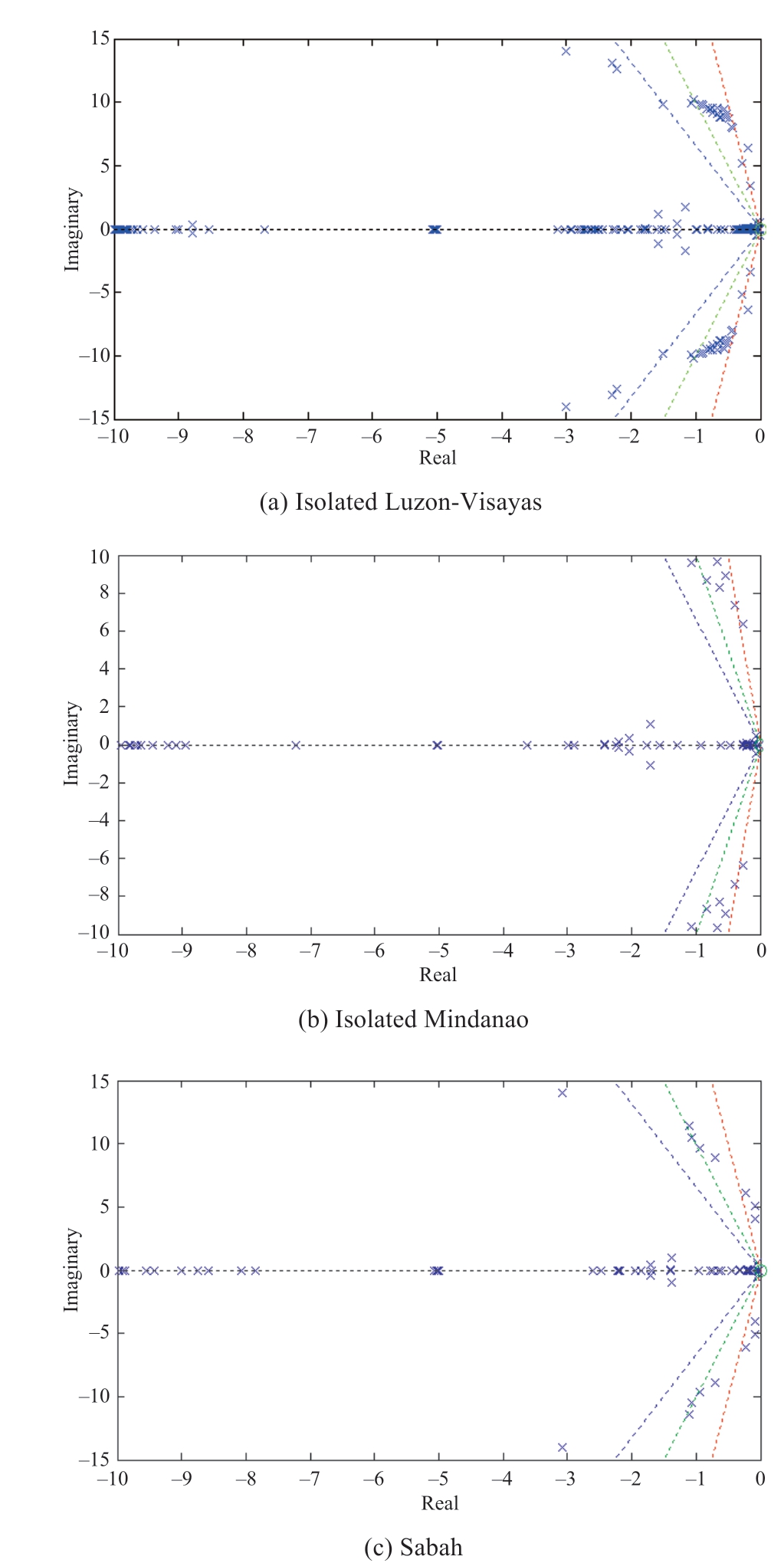
Fig.4 Philippine PSAT model eigenvalues
This instability was resolved by reducing the clearing time to 0.7 s instead of 0.8333 s, which could be an issue if the circuit breaker does not work faster than five cycles.This implies that a practical system should include faster and more efficient protective devices for withstanding large disturbances.This system is shown in Figures 5c and 5d.This demonstrates the sensitivity of the system to the type of fault applied at certain locations.
2.2 Interconnected models (Philippine Power Grid)
The Philippine national power grid will be achieved if the proposed link between Visayas and Mindanao is installed.When the proposed link was installed in the model, the system exhibited small signal instability with two positive eigenvalues.Synchronous machine no.10, located in Visayas, contributed to this instability, as indicated by the participation factor.Synchronous machine No.10 accounted for 18.87% of the state of eigenvalue Nos.195 and 196.

Fig.5 Luzon-Visayas link model time domain simulation results
Table 1 shows the original critically damped eigenvalues.It can be seen that same, as the values given in Table 1, rotor angle and speed have the least damping ratio compared to other states.It is interesting to note the -1.535% damping ratio of the synchronous machine 10.Examining its mode, 0.565571 Hz, it means that the instability is in inter-area mode.The following sections will discuss the grid’s instability and acquired stability with the help of power system stabilizers (PSS), which is based on the unstable/weak eigenvalue participation factor.
As shown in Fig.6, the system experienced instability as indicated by the presence of one complex pair of eigenvalues(highlighted in red) located on the right-half of the S-plane.A total of 422 states with 67 complex pairs were initialized and observed.Two positive eigenvalues were observed in the impending interconnection between the Mindanao and main grids.The eigenvalues of the system with machine No.10 became unstable.This is probably because of the approximate and reduced models.For the analysis,participation factors were used to determine the bus that was weakly damped and most exposed to instability.Generators with the highest participation factors are optimal locations where power oscillation dampers (POD), for example,PSS should be placed to improve stability.When PSS was installed in the unstable generator, Syn_10, the eigenvalues(Fig.7b) became stable.The damping ratio improved from a value of -1.12% to a value of 6.4%.With the correct parameters of PSS, the real part of the eigenvalue Nos.195 and 196 became negative (-0.22186).
For transient stability, unlike the synchronous machines in the area (Fig.7a) where the fault was applied, machine no.10 in Visayas became unstable, as shown in Fig.7b.This is evident in all generators to which this unstable generator belongs.It oscillated after the fault instead of returning to its original value.This is attributed to the unstable states shown in the eigenvalue analysis.The amplitude of the oscillation continues to increase, as shown.The rotor angle has been evident in showing instability as well.

Fig.6 Philippine PSAT model eigenvalues
It can be perceived in Fig.7c that the swinging of the faulted generator has minimal fluctuations.It can be seen in the zoomed graph (Fig.7d) that the angle is starting to be unstable, as seen by the fluctuations in the oscillation with increasing amplitude.
PSS has effects on the transient stability of the system too.The voltage profile of machine No.24, where the fault bus is attached, shows no significant change in its profile after installing the PSS in the system, as shown in Fig.8a.However, the significant improvement was characterized by machine No.10.It can be seen in Fig.8b the improvement in the voltage of the profile.This zoomedin Fig.8c illustrates how the system tried to compensate for the fault by maintaining the voltage levels at the buses.It is noteworthy to examine machine No.10 since this is where the PSS is installed through its AVR to facilitate the voltage regulation of the machine.
2.3 Interconnected models (Philippine-Sabah Power Grid)
The stable model of the entire Philippine power grid was utilized when the link to the Sabah power grid was done.The whole system is composed of 126 buses with 531states considered, 80 of which are complex pairs.Figure 9 shows that the system is stable when small disturbances are concerned.
Table 1 Critical modes of the Philippine power grid


Fig.7 Voltage of synchronous machines without PSS
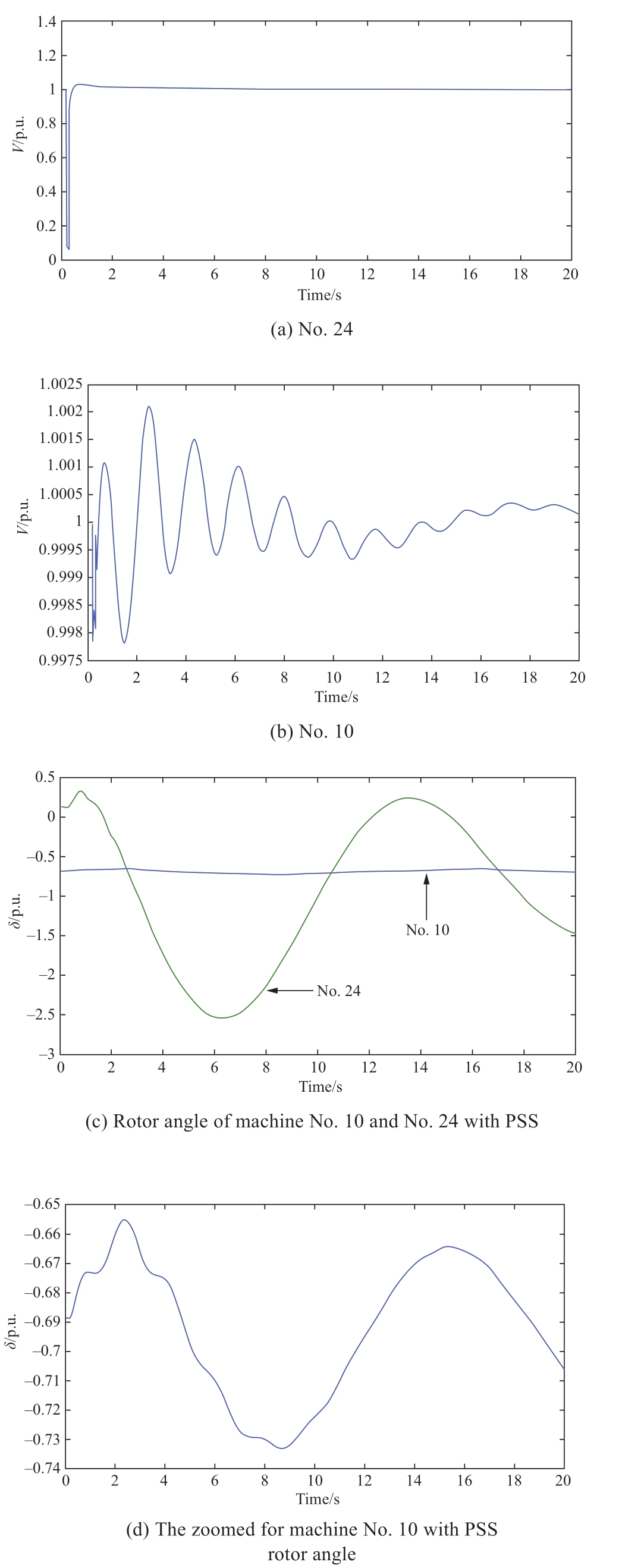
Fig.8 Voltage of synchronous machine with PSS
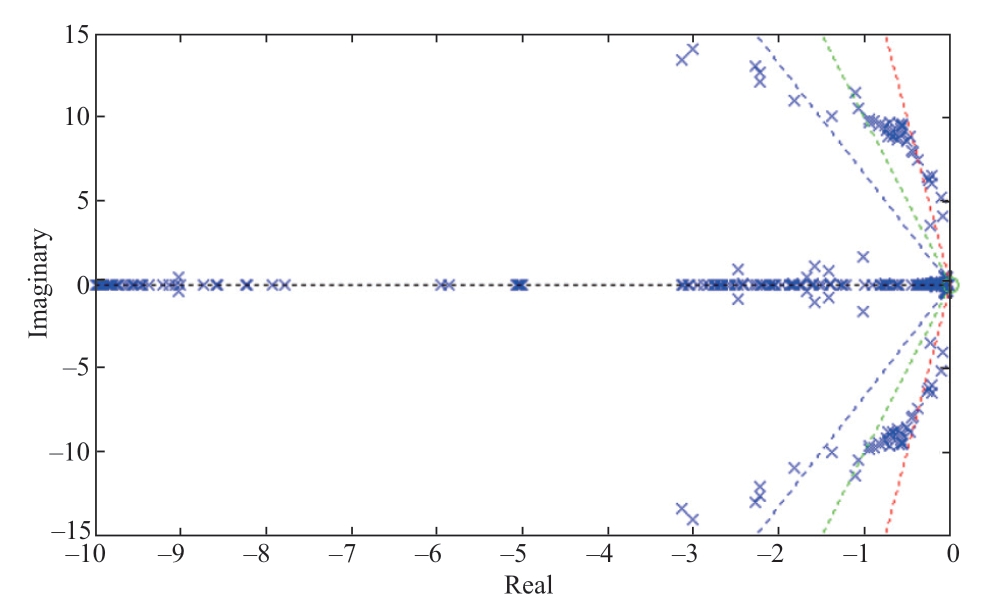
Fig.9 Philippine–Sabah model eigenvalues
The eigenvalues are listed in Table 2, and the same states, rotor angle, and rotor speed significantly influence the instability of the system.This is also true when studying the Myanmar Grid system [18].This may be why, of all the dynamic parts, it is the one that is closely taken into account.The critical modes are mostly local aside from the eigenvalue No.196 and 197, which is inter-area.This may be due to the tie-lines between these 5 areas.Since this is asynchronous interconnection, a strong HVDC transmission line should be installed (already in the plan [4]) to improve this eigenvalue.The parameters of the HVDC link used in this study are based on the models in IEEE [25].
The result of this eigenvalue analysis validates that the connection of the Philippines to Sabah is possible and imposes no major problem when the small-signal stability of the system is concerned.
Fault analysis was also conducted on the system.The voltage behavior of the entire system when a fault is introduced in one of the buses in Mindanao is relatively stable.This location was selected because Mindanao is the most troubled of all the grids owing to its low capacity;therefore, most problems may occur in this area.The system rotor angles did not exhibit any evidence of instability.The fluctuations that occur during the fault smooth with time.
2.4 Philippine-Sabah Power Grid with High Penetration of Renewable Energy Sources
The system study also extended subject to high penetration of renewable energy resources, specifically solar photovoltaic and wind turbines in the future.The data are from the Department of Energy as of February 28, 2014 [6], and also available from The National Grid of the Philippines’(NGCP) Transmission Development Plan Volume 1.However, only the wind power plants and solar power plants that are planned to be erected are considered in this work.The assignment of the lumped wind and solar PV farms is based on the geographical location of such power plants, to which they are proximate to a certain bus in the model where the plants are connected.Reference [26]indicated no immediate plans for additional solar PV and wind farms until Sabah in 2023.The load flow results of the entire system complied with the standards set by the Philippines’Energy Regulatory Commission [27].Figure 10 shows the voltage levels of all 133 buses present in the system, with the addition of 7 buses intended for the RE sources injected in the system that has the planned capacity for the year 2023.The total real and reactive loads were 88.4423 and 11.7391 p.u., respectively.Similarly, the total real and reactive power generations were 91.6839 and 24.0990 p.u., respectively.However,total system real and reactive power losses were 3.2317 and 12.3699 p.u., respectively.Small-signal stability analysis was performed by comparing the eigenvalues during the gradual increase in renewable energy sources in the system.The system could withstand up to a 40% increase, as shown in Table 3.Increasing the RE sources by 50% led to malfunctioning of the system components.Table 3 lists the eigenvalues of the critically damped modes.
Table 2 Critical modes of the Philippine-Sabah power grid

Table 3 Damping ratios of the Philippine–Sabah grid with increasing penetration of renewable energy

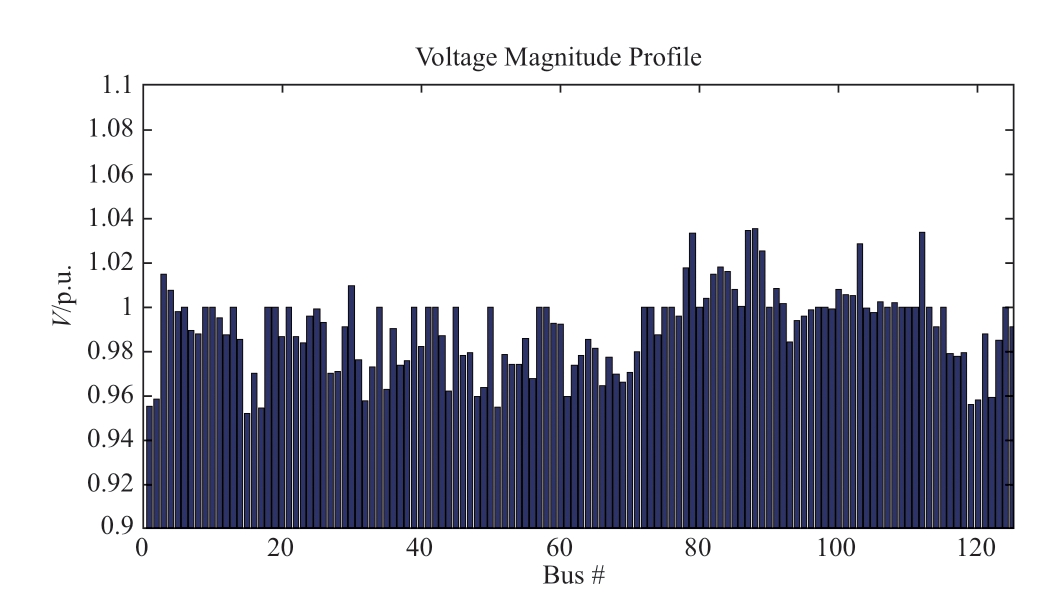
Fig.10 Philippine–Sabah model with high penetration of RE voltage profile and summary of power flow
The base case is a scenario in where the system is installed with renewable energy resources as planned for 2023, and its damping ratios were considered.The damping ratios of the critically damped modes were compared to visualize which machines have been improving during the growth of RE in the system.
Table 3 has the damping ratios enlisted.Machines 40 and 18 have no visible changes because these machines are located in the Sabah grid with no RE installed, so even the RE penetration increase will not affect the machines,whereas the other three machines have increased their damping ratios considerably with respect to the base case.
From Table 3, it can be deduced that the increased RE penetration in the system improved the critically damped eigenvalues, probably because of the reconfiguration of power flows among the corridors/lines after installing distributed RE sources at different locations.
The time domain simulation results were also evaluated by adding more renewable energy sources to the system.Two subcases were considered in this evaluation.First, the capacity of traditional generators of the buses, where the RE sources are installed is reduced.In the second case, the load increased to the same value as RE generation increased in the region.The load was distributed mostly throughout the area where RE generation was located.The main focus of this study was wind and solar penetration.
A three-phase fault in the most troubled area (Mindanao)was considered to simulate the behavior of the system when subjected to a large disturbance.In the simulation, the fault was applied at 0.2 s, followed by a clearing time of 5 cycles(0.0833 s).
When the generation of solar and wind power plants is increased by 20%, the system characteristics, particularly the voltage for Visayas (weak area), are shown in Fig.11.Figure 11a shows the Visayas area was stable when the generation from nearby traditional power sources decreased.However, in the second case, the system became unstable,as shown in Fig.11b.The instability was solved in Fig.11c by acknowledging the role of the wind turbines not being appropriately initialized.Appropriate parameters stabilize the system.The magnetic reactances of DIFG 3 and DFIG 4 located at buses 79 and 77, respectively, increased.This shows the sensitivity of the system parameters when the transient stability is considered.Hence, this signifies the role of the initialization of the dynamic components by power flow analysis.

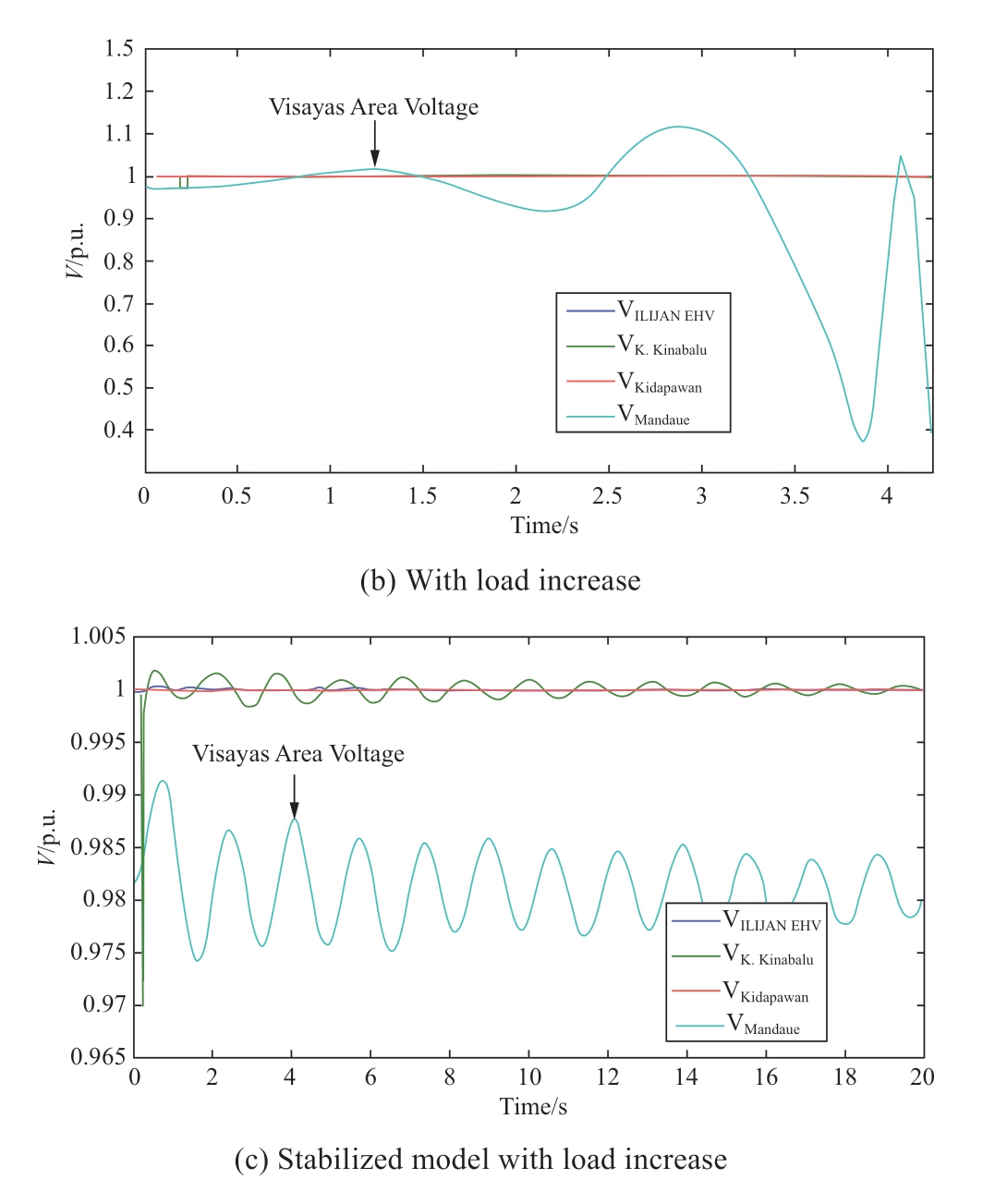
Fig.11 Philippine–Sabah model voltage per area with 20%increase in penetration of RE
3 Conclusions and recommendations
This study presents a stability study of the Philippines’power grid that is connected to the Sabah power grid as part of the planned ASEAN Power Grid.The results show that all three interconnected islands pose stability threats but can be stabilized using a power system stabilizer.In addition,the Sabah interconnection does not significantly challenge the stability of the grid.However, an interconnected power system exhibits instability issues at moderate penetration of renewable sources, which require a stabilization mechanism for a higher penetration level.
The author recommends for future researchers:
·To include other analyses like voltage stability and line contingency.
·To have more practical data and the economic aspect of this interconnection.
·To expand the scope of the study among neighboring countries (such as Malaysia, Brunei, and Indonesia) to study international cooperation, such as ASEAN as a whole or the Asian Super Grid.
Acknowledgements
The authors would like to thank Engr.Edwin B.Cano of the NYISO for the generous support by providing data for the Philippine power system, PSAT program developer, and all concerned persons/organizations contributed either way.
Declaration of Competing Interest
We declare that we have no conflict of interest.
References
[1] Atchatavivan P (2005) ASEAN energy cooperation: an opportunity for regional sustainable energy development.In: Mimeo, Papers on International Environmental Negotiation series, MIT-Harvard Public Disputes Program, Harvard Law School
[2] Montaño A M, Ruiz E Y, Morataya J C, et al.(2006) Stability analysis for the electrical integration of Ecuador, Colombia and Panama.Proceedings of IEEE PES Transmission and Distribution Conference and Exposition Latin America.Caracas, Venezuela,2006
[3] Kundur P (1994) Power system stability and control.McGraw-Hill, New York, NY, USA
[4] AIMS II Report (2011) ASEAN interconnection master plan study-2, http://www.hapuasecretariat.org/doc2011/Vol_I_Executive%20Summary.pdf.Accessed Nov 2015
[5] Cano E B, Shaikh F A (2013) Reduced and approximate models of philippine major island power grids.Proceedings of International Conference on Power, Energy and Control (ICPEC),2013
[6] Transmission development plan (2013) Final report, national grid corporation of the Philippines https://www.ngcp.ph/savefiles/news/BULLETINS/2013%20 TDP%20Consultation%20Draft_VolI-Major%20Network%20 Development.pdf.Accessed Oct 2015
[7] Marbun M P, Salile A Y, Surya A S (2018) Grid impact study of variable renewable energy integration to Java-Bali system.Proceedings of 2018 8th International Conference on Power and Energy Systems (ICPES), pp 182-189, doi: 10.1109/ICPESYS.2018.8626922
[8] Mararakanye N, Bekker B (2019) Renewable energy integration impacts within the context of generator type, penetration level and grid characteristics, Renewable and Sustainable Energy Reviews, 108: 441-451
[9] Beyza J, Yusta J M (2021) The effects of the high penetration of renewable energies on the reliability and vulnerability of interconnected electric power systems, Reliability Engineering &System Safety, 215: 107881
[10] Erdiwansyah, Mahidin, Husin H, et al.(2021) A critical review of the integration of renewable energy sources with various technologies.Protection and Control of Modern Power Systems,6(1): 1-18
[11] Smith O, Cattell O, Farcot E, et al.(2022) The effect of renewable energy incorporation on power grid stability and resilience.Science Advances, 8(9), doi:10.1126/sciadv.abj6734
[12] International Energy Agency (2021) Countries and regions.https://www.iea.org/.Accessed 25 Dec 2022
[13] Li J, Xu J, Tan X (2018) Dynamic comprehensive benefit evaluation of the transnational tower grid interconnection project based on combination weighting and TOPSIS Grey projection method.Sustainability, 10(12): 4672
[14] Brinkerink M, Gallachóir B Ó, Deane P (2019) A comprehensive review on the benefits and challenges of global power grids and intercontinental interconnectors.Renewable and Sustainable Energy Reviews, 107: 274-287, https://doi.org/10.1016/j.rser.2019.03.003
[15] Alzakkar A, Vladimirovich M V, Samofalov Y, et al.(2022) The impact of electrical interconnection between countries on the stability of electrical power systems.Proceedings of 2022 4th International Youth Conference on Radio Electronics, Electrical and Power Engineering (REEPE), Moscow, Russian Federation,pp.1-6, doi: 10.1109/REEPE53907.2022.9731442
[16] Pham T N, Trinh H, Hien L V (2016) Load frequency control of power systems with electric vehicles and diverse transmission links using distributed functional observers.IEEE Trans Smart Grid, 7(1): 238-252, doi: 10.1109/TSG.2015.2449877
[17] Chen G, Li Z, Zhang Z, et al.(2020) An improved ACO algorithm optimized fuzzy PID controller for load frequency control in multi area interconnected power systems.IEEE Access,8: 6429-6447, doi: 10.1109/ACCESS.2019.2960380
[18] Krishan R, Verma A, Prasad B (2014) Small signal stability analysis of grid connected distributed PV and wind energy system.Proceedings of 6th IEEE Power India International Conference (PIICON), Delhi, India, 5-7 December 2014, p 6
[19] WESM Market Network Model (WESM-MNM).http://www.wesm.ph/inner.php/downloads/market_network_model,Accessed 23 Feb 2016
[20] Milano F (2010) Power system modelling and scripting.Springer,London, Dordrecht Heidelberg, New York
[21] Alhelou H H, Golshan M E H, Hatziargyriou N D (2020)Deterministic dynamic state estimation-based optimal LFC for interconnected power systems using unknown input observer.IEEE Transactions on Smart Grid, 11(2): 1582-1592, doi:10.1109/TSG.2019.2940199
[22] Stevenson W D (1984) Elements of power system analysis.4th edition, McGraw-Hill, New York, pp 428
[23] Sabah Electricity Supply Industry Outlook (October 2014)Suruhanjaya Tenaga Energy Commission.http://www.st.gov.my/index.php/component/k2/item/607-sabah-electricity-supplyindustry-outlook-2014.html.Accessed 25 Jan 2016
[24] Lin M K (2014) Small signal stability assessment of MEPE test system in free and open source software.International Journal of Electrical, Computer, Electronics and Communication Engineering, 8(11): 158-166
[25] Chompoobutrgool Y, Li W, Vanfretti L (2012) Development and implementation of a Nordic grid model for power system small-signal and transient stability studies in a free and open source software.Proceedings of IEEE Power and Energy Society General Meeting, San Diego, CA., 22-26 July 2012, p 8
[26] Asian Development Bank (2003) Project completion report on the Leyte-Mindanao interconnection engineering project (Loan 1474-PHI) in the Philippines.http://www.adb.org/sites/default/files/project-document/70576/pcr-phi-30007.pdf.Accessed 15th Jan 2015
[27] Energy Regulatory Commission (2014) Implementing single outage contingency (N-1) operational criterion.www.erc.gov.ph/Files/Render/media/N-1OperationalCriteria.pdf.Acccessed 12 March 2016
Appendix A
Line data

continue

continue

continue
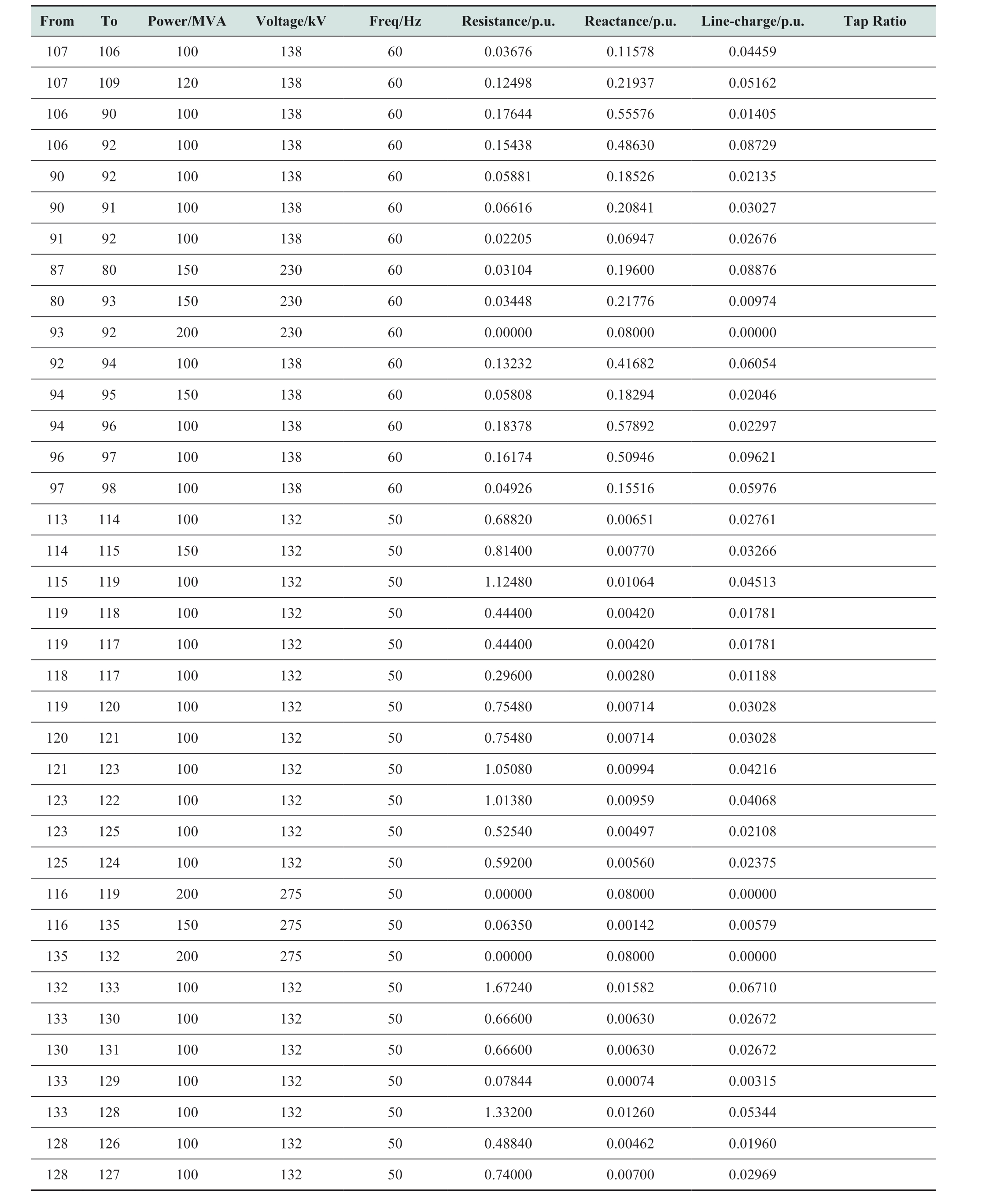
Bus data
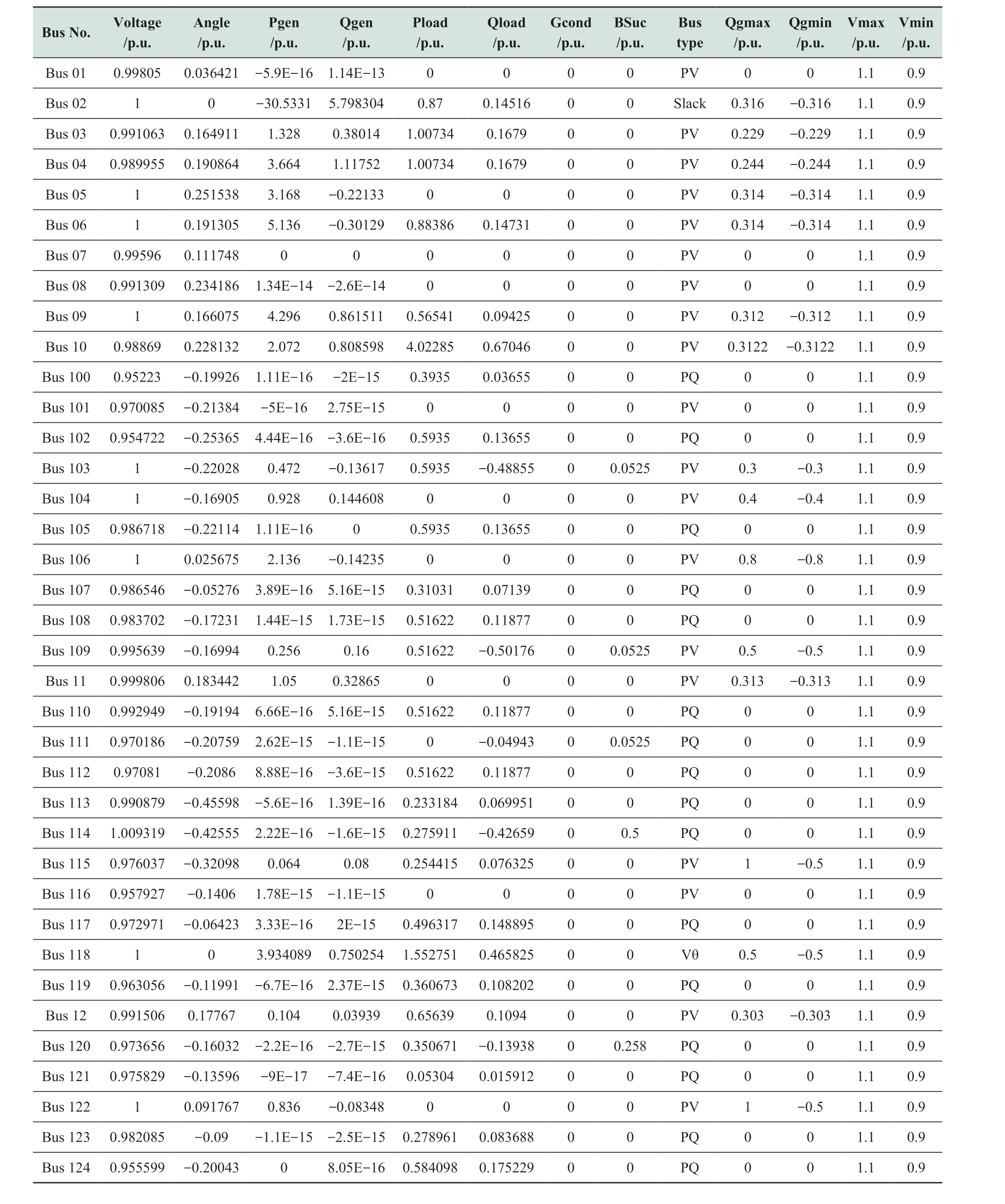
continue
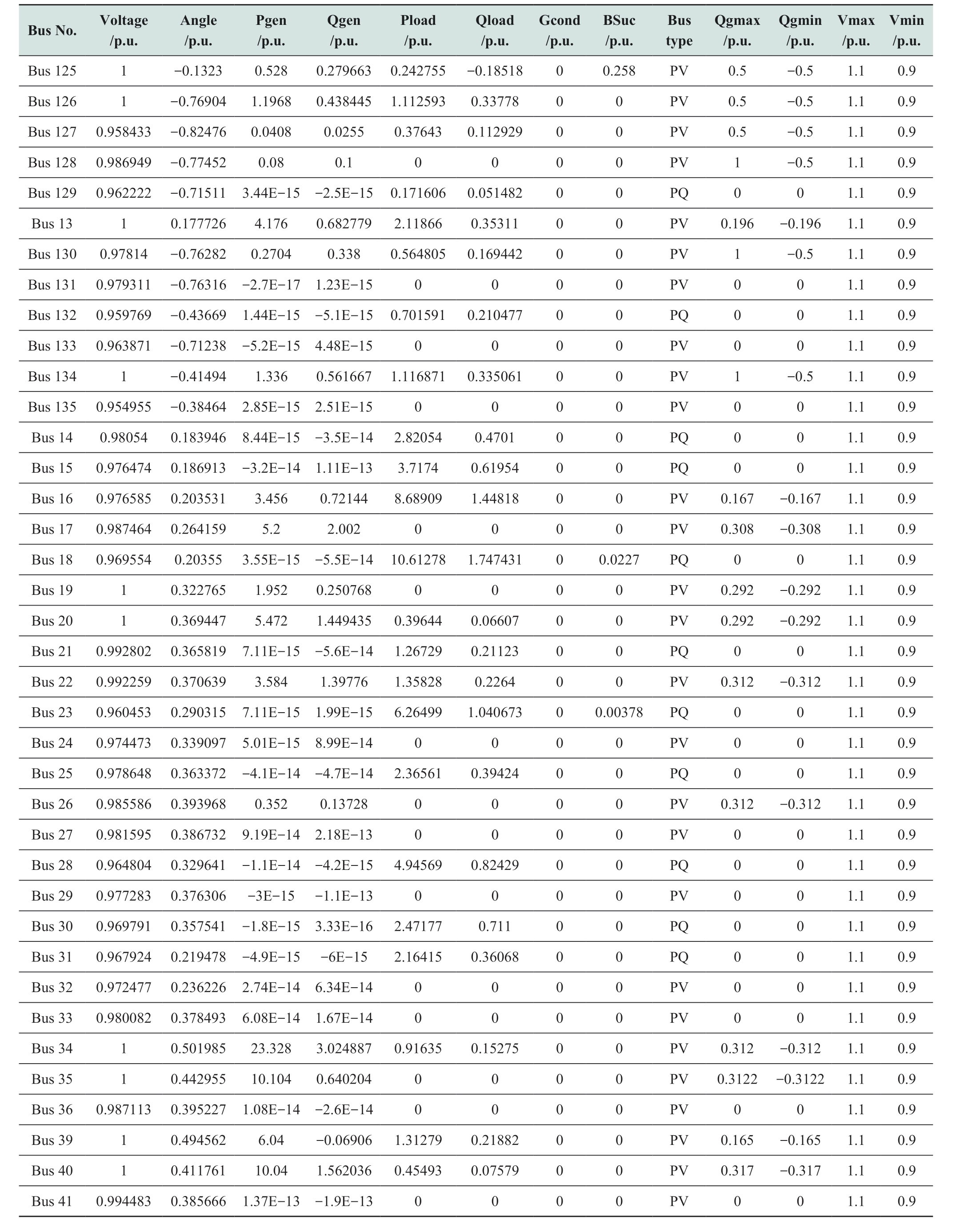
continue

continue
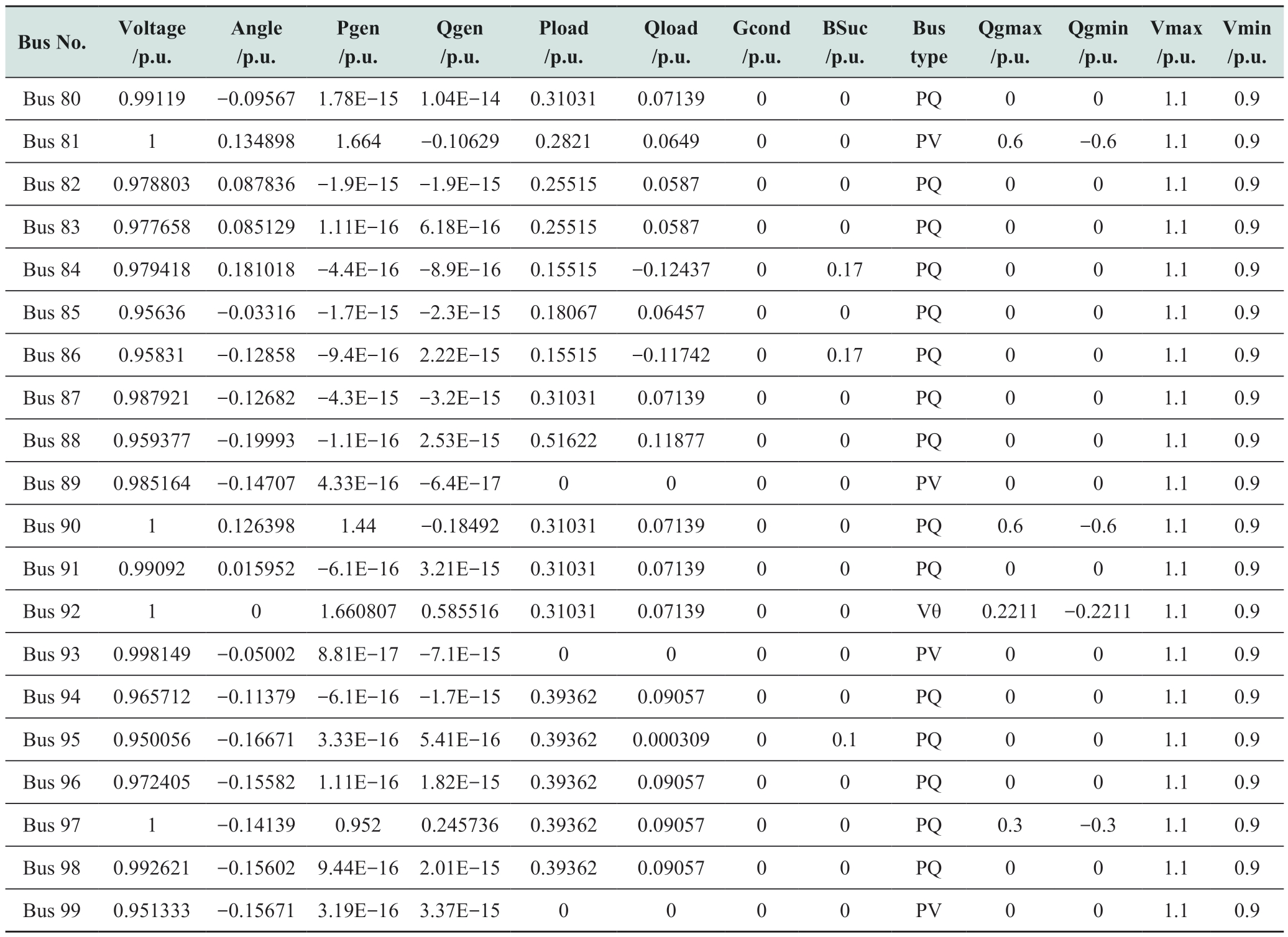
Received: 7 January 2023/ Accepted: 3 May 2023/ Published: 25 June 2023
Jai Govind Singh
jgsingh@ait.ac.th
Tristan G.Magallones, Jr.
tristanmagallones@gmail.com
2096-5117/© 2023 Global Energy Interconnection Development and Cooperation Organization.Production and hosting by Elsevier B.V.on behalf of KeAi Communications Co., Ltd.This is an open access article under the CC BY-NC-ND license (http: //creativecommons.org/licenses/by-nc-nd/4.0/ ).
Biographies

Mr.Tristan G Magallones Jr received his Master of Engineering degree, Major in Energy at Asian Institute of Technology(AIT), Klong Luang, Pathumthani, Thailand,2016.He received his Bachelor of Science in Electrical Engineering at Central Mindanao University (CMU), Musuan, Maramag Bukidnon, Philippines last 2011.He is working towards his PhD in Energy Engineering degree at University of the Philippines Diliman, Quezon City,Philippines.Currently, he is also working as a faculty member at Central Mindanao University in Bukidnon, Philippines.His research interests include power system stability studies and renewable energy integration studies.

Dr.Jai Govind Singh received a Ph.D.degree from IIT Kanpur.Currently, he is working as an Associate Professor at the Department of Energy, Environment and Climate Change,SERD, Asian Institute of Technology (AIT),Bangkok, Thailand.Prior to joining AIT, he worked as a Postdoctoral Research Associate at the KTH Royal Institute of Technology(KTH), Stockholm, Sweden, and as a postdoctoral research fellow at the University of Queensland, Brisbane, Australia.So far, he has supervised seven doctoral and 70 master’s students and has published more than 100 research papers in peer-reviewed international journals and conference proceedings.His teaching and research interests include power system planning, operation, and control, smart grids and microgrids; electric vehicles and battery storage, deregulation,solar and wind integration, and power distribution system planning.He is a fellow of The Institution of Engineers, India.
(Editor Yajun Zou)
